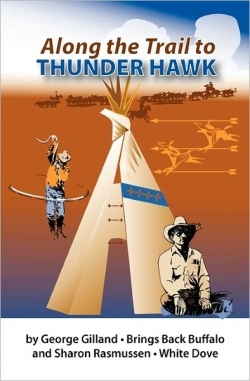Along the Trail to THUNDER HAWK
The West provides the legends of the American people, and so the authors have done a service by novelizing the tales they once heard as the grew up in the Dakotas, all the more important because the people chronicled sadly remain shadowed. Robert “Bob” Gilland was a half-breed*.* Red Eagle was his Lakota name.
Red Eagle’s father was Ben Gilland, an Army sergeant in the Dakota Territory. Gilland resigned in 1881 to marry Elizabeth Red Bird McEldery, a young woman from the Standing Rock Reservation. Custer was dead, but the massacre at Wounded Knee was still to come. Prejudice flourished.
The young couple was allowed to run 250 head of cattle on the reservation without grazing fees, and so they took up ranching, first on the Blackfoot Creek Ranch and then moving to the West River Country near Thunder Hawk, where Ben and his sons eventually homesteaded more land, raising cattle and horses. Although Ben and his oldest son, also named Ben, appear, it is Bob’s story, one full of hard-knocks in the rough-and-tumble land where the Dakotas edge up on Montana.
A history buff might quibble that the authors concentrate on anecdotes without offering the emotional sense of living in the rugged environment and facing everyday hardships—riding hundreds of miles on horseback, driving cattle, surviving a blizzard—so foreign to a person today with an automobile and central heating and air-conditioning. But only the strong survived, and the strong were stoic and single-minded.
“It was about six miles back to camp and my horse went a bouncing along,
I hadn’t noticed before just how rough a riding horse he was. But he finally
bounced himself home, and I turned him loose and headed to the house
and just flopped down on my bed.“
Another central character in the book is Brave Bear, Bob’s contemporary. They met at Indian School where Lakota children were sent to learn the white world’s ways. That process included washing out the students’ mouths with soap if they were caught speaking their native language.
Bob and Brave Bear grew up to cowboy together, including a stint as detectives for the Montana Cattlemen’s Association, but the young men weren’t averse to female companionship: “Two of them, Babe and Florence Goodreau, were about our age and single and pretty all over more than anywhere else.”
In the West of the early 1900s, men still went about armed, and with that, Brave Bear came to no good end. Known to skirt the law on occasion, he was apparently shot down by a posse. But Brave Bear lived long enough to see Bob face a possible life sentence in Leavenworth Prison.
Bob had been on a cattle drive. Among the other cowboys was his unfriendly cousin. Too much alcohol led to a gunfight, and Bob killed the man in self-defense. A prejudicial judicial system and absent witnesses led to Bob facing a life sentence conviction that was eventually reduced to manslaughter. The novel ends with Bob on the way to Texas after enlisting at the beginning of World War I.
Along the Trail to THUNDER HAWK is an excellent example of folklore literature. Those who enjoyed Lonesome Dove or Little Big Man might hanker for an opportunity to sit on a veranda with Bob Gilland, watch the sun set over the Great Plains, and listen to a real cowboy’s stories.
Reviewed by
Gary Presley
Disclosure: This article is not an endorsement, but a review. The publisher of this book provided free copies of the book and paid a small fee to have their book reviewed by a professional reviewer. Foreword Reviews and Clarion Reviews make no guarantee that the publisher will receive a positive review. Foreword Magazine, Inc. is disclosing this in accordance with the Federal Trade Commission’s 16 CFR, Part 255.

